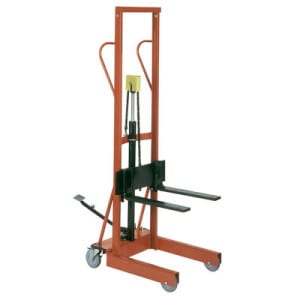 Hydraulic equipment can be one of the most useful and versatile pieces of lifting equipment you own, both for moving and placing materials onto shelving or into working position — without the expense of recharging that is incurred by electrical equipment of the same sort.
Hydraulic equipment can be one of the most useful and versatile pieces of lifting equipment you own, both for moving and placing materials onto shelving or into working position — without the expense of recharging that is incurred by electrical equipment of the same sort.
While both types of lifting equipment have their place, for small to medium sized loads hydraulic equipment can be just as efficient as and less costly than their electric counterparts.
One thing to keep in mind when purchasing your lifting equipment is the ongoing care and maintenance that will be required.
Hydraulic equipment, like any other, has special maintenance requirements that, if kept, will keep your lifting equipment working well over a long period of time.
Here is a bit more about what you need to do to properly maintain hydraulic lifting equipment.
Knowing How It Works Helps to Know What to Watch
Hydraulics basically involve a large cylinder with a pistol inside that is forced upwards to lift the load. What provides the lifting power is hydraulic oil inside the pistol, which has an increased force because it is put under pressure by applying a force such as a foot pump. With the hydraulic system being contained any added pressure applied by the foot pump will apply a pressure to the piston, raising the load into the air.
Think of hydraulics like a water pistol. By pushing the plunger you squirt the water out of the end, but if you did the reverse and pushed on the water in the barrel your small force can be enlarged to push on the plunger of the water gun. In order to keep the pressure equal in the water gun, a small force on the smaller diameter barrel will create a larger force on the large plunger area.
So the important thing to remember in this system is that the oil volume must remain constant for the hydraulics to work properly. So make sure you check the oil volume and pressure during your routine maintenance. Be sure to periodically replace old oil with a good quality hydraulic oil per the manufacturers recommendations for your lifting equipment. Maintaining the hydraulic oil is the first line of defense against failure of the lifting system of your equipment.
If you are wondering if hydraulic lifting equipment if right for you, here are some easily maintained models that we can recommend:
Hydraulic Lite-Lift Model LLHF
This small manual winch model stacker from Wesco has a capacity of 500 pounds with a hydraulic pedalift jack. The foot operated hydraulic pump will lift a small skid to a height of 54” and is great for smaller applications. Casters include wheel locks and the unit has an overall dimension of width 20”, height 70.5”, depth 30” and a weight of 139 pounds.
Powered Telescoping Fork Stacker
This stacker is made for lifting heavy loads onto shelving, and is almost like a small walk behind forklift. The unit has adjustable forks that lower right to the floor, ergonomic “D” handles for easy steering, and a heavy-duty foot pump.
A high strength mast provides increased stability, and fifth wheel steering provides greater mobility and precision steering in confined areas.
Dimensions are width 48”, height 87.5”, depth 68” with a steel frame and a capacity of 2000 pounds, which it can lift over ten feet into the air. The stacker weighs 1240 pounds and incorporates 8” locking polyurethane drive wheels and 6” nylon casters at the front.
Other Factors to Maintain on Your Lifting Equipment
Of course the hydraulics are not the only part of your lifting equipment that you will need to maintain. The wheels and casters can also incur problems that affect your ability to use the lifting equipment properly. The ability to move your hydraulic lift equipment is only possible with properly maintained wheels and casters, and here are some things to watch for that can cause troubles:
Caster Maintenance
If your wheels and casters do not have sealed in grease, they may need attention. Excess temperatures or washing can remove the grease that makes your caster roll properly, and will then need to be replaced. When this is the case, routinely apply an adequate lubricant on the caster to keep it moving smoothly.
Damage or Wear
The wheels and casters on lifting equipment are not indestructible, and can sustain damage that will cause problems in the wheel turning. This can be as simple as a string binding in the wheel, which causes a flat spot to appear, or nicks in the wheel material that can cause the wheels to turn and steer in a strange manner.
It is best to check the wheels on your equipment regularly to make sure that there are not underlying problems that can become much larger over time. It is better to change your casters early before they create difficulties that can impede productivity.
Get help choosing the best hydraulic lifter for your needs or let us help you troubleshoot an issue with your existing equipment. Give us a call at 800-451-0030 now.




